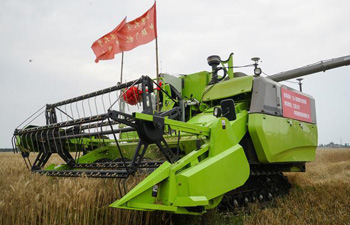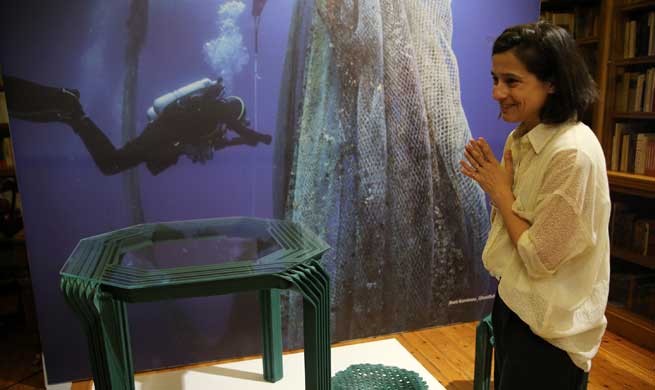By Xinhua writers Lyu Qiuping and Yin Siyuan
TIANJIN, June 3 (Xinhua) -- Wang Zhenghua describes himself as "voice sculptor," carving melodies out of pieces of wood.
Producing a hand-made violin is far from easy. Wang is completely in charge of every stage of the process from sourcing the materials through molding, varnishing and tuning.
"It takes at least 200 working hours to give life to a violin," he says.
The instruments he makes are worth more than 100,000 yuan (15,600 U.S. dollars) each, according to the violin association of China.
Wang was born into a teacher's family in the port city of Tianjin in 1949, when the People's Republic of China was founded.
For forty years, he has made and repaired countless violins at home or abroad, and has observed the changes in both China and in the people's attitude toward Western music.
SURPRISING ENCOUNTERS
Wang started making and repairing violins when he accidentally broke his own.
He has been fond of music since childhood. During junior high, he began learning Chinese string instrument Erhu - a kind of two-stringed fiddle - at an after-school club, where he first saw a violin.
"I was immediately stunned by its gorgeous shape and beautiful tone, and decided I had to have one," he recalls.
Few Chinese families had access to musical instruments, especially Western instruments like the violin back then, and Wang's wish did not come true until he was 20. His father bought his first violin at a pawnshop for 30 yuan, about a month's salary for a teacher at that time.
"I just couldn't hide my excitement, and cycled miles from the village where I worked to pick it up," recalls Wang, who had been sent to rural Tianjin as a "zhiqing," an educated youth.
At the behest of Mao Zedong, more than 10 million zhiqing were sent into the countryside for farmwork from the 1950s to the 1970s. Wang volunteered to deliver manure, a dirty, smelly, night duty that was hated by most, but which granted him free time during the day to practice the violin.
"I kept imitating the playing pose while driving a donkey cart at work. After some sleep in the morning, I had the entire afternoon for practising," he says. He also turned to a violinist in the city for instruction.
In 1976, a devastating earthquake struck neighboring Tangshan. Wang and his fellow workers moved in tents, where his violin cracked after days in the cold.
"I was depressed as my family had no spare money for a second one, " he says.
So he resolved to make his own, with an awl, a file and sharp pieces of glass, which he found a good tool to form the wood curves.
"I kept smashing glass until I found the ideal shape of piece." In making the violin, he had no instructor and only his broken one as an example. It took him six months to finish.
Wang took the college entrance exam in the late 1970s, one of two applicants for a single vacancy on the violin-making major at Beijing's Central Conservatory of Music, and failed.
While he was planning to prepare for the exam next year, Tianjin Opera and Dance Theater advertised for an instrument repairman for its symphony orchestra.
"Few people could have done it," he says.
Wang got the job when the municipal bureau of culture had his rural hukou (residential registration) converted to an urban one. In the following 16 years, he repaired instruments at the theater, and became a self-taught master.
After China opened its door to the outside world in 1978, many people have traveled overseas. Wang wanted to join them to find more about Western instruments and the skills involved in making them.
SURPRISE OVERSEAS
Wang finally went to the United States in 1997, when a former apprentice of his found him a job at the Washington Music Center.
Upon arrival, he was amazed by the high-rises and houses there.
"I thought rich people lived in big houses, not knowing that there were villas and mansions elsewhere," he recalls.
As the first Chinese repairman at the music center, Wang was not really trusted.
"No one thought a Chinese could fix a Western instrument until I repaired a completely broken violin that none of them had even tried to repair," Wang says.
Since then, he has worked with top musicians, and repaired thousands of violins in Washington over a decade.
He was also surprised by the concert customs there. He went to a symphony concert with casual clothes, only to find the others were all in suits.
"The formal dress shows their respect for music, due to their education since their childhood," he says.
SURPRISE BACK HOME
Wang came back to China to take care of his ailing mother in 2007. He was as surprised as he was when he first landed the United States by the emerging domestic high-end violin market.
China's expanding middle-income group has created a lucrative market for quality products. Parents send their children for music and dance classes.
"In the past, few parents cared about anything other than academic performance," he says.
Wang now runs a workshop which makes no more than 20 violins a year, all commissioned.
"I enjoy making violins," Wang says.
His son works in IT and is unlikely to learn violin making.
"China has become the world's largest violin producer. There are many people looking for quality violins," Wang says, "I would teach whoever is interested."

















